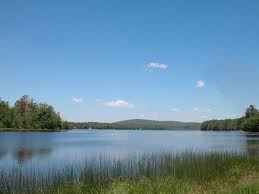Rain Gardens Save Water Quality for Maine Lakefront Real Estate

Sibley Pond, Pittsfield & Canaan, Maine, Offers Lakefront Home Owners Plenty of Wildlife Viewings
June 7, 2012
Out and About for the Mid Coast Region of Maine June 14-20
June 13, 2012Rain Gardens Save Water Quality for Maine Lakefront Real Estate

Stunning Sunset over Sebago Lake in the Sebago Lakes Region of Maine
As Maine lakefront property owners, we’re always looking for ways to protect the water quality. Laura Wilson of the UMaine Cooperative Extension tells us that about half of the water that falls on the ground infiltrates into a forested landscape, about 10% runs off the surface and about 40% evaporates.
During a downpour, water gushes of the roof of your lakefront camp, cabin or cottage and dumps phosphorus and other pollutants into your lake or pond. By building a rain garden, you can divert that water into an attractive planting bed that works like a sponge and natural filter as it percolates slowly into the surrounding soil.
Rain gardens are low impact tools that look similar to most gardens, except they’re neither raised nor flat. They’re built in a shallow depression and are bowl-shaped. At a glance, your rain garden may not look like anything more than a well-manicured garden overflowing with native grasses and wildflowers, but beneath the surface, it’s actually an expertly designed tool used to protect against water contamination.
Rain gardens aid the filtration process by taking in storm water runoff from impervious surfaces and eliminating some pollutants before the water makes its way into aquifers. They also make the amount of storm water runoff more manageable by absorbing excess liquid. Once the water reaches the rain garden, a mixture of amended soils absorbs the water and strains it like a sieve, filtering out sediment and other pollutants, including phosphorus.
Rain gardens mimic a forest because they’re built to have layers of vegetation and thick spongy soils. They are not meant to hold water like a pond or a wetland–a properly functioning rain garden will hold water for no more than a couple days after a storm.
For water quality purposes, the waterfront home owner needs to determine how much rain should be captured. Laura suggests that you should capture one third of the impervious surface, so if you have a 1,000 square foot camp roof, you need to plan a 300 square foot garden.
Creating a rain garden is a simple process, but does take some planning. You’ll need to consider design, including size, placement, shape and plants.
Visiting rain gardens around the state will help you. Two we suggest you visit are at Laura Wilson’s office, 495 College Avenue in Orono and at the Sebago Lake Ecology Center, intersection of Routes 237 & 35 in Standish. The Cooperative Extension also offers the following publication to help you: Adding a Rain Garden to your Landscape
To learn more about lakefront property listings for sale on Sebago Lake, just click on the green button above.
To read blogs about Sebago Lake, take a look at these:
Sebago Lake – When Only a Big Maine Lake Will Do
Sebago Lake – Facts for the Lakefront Lover of Big Sebago

